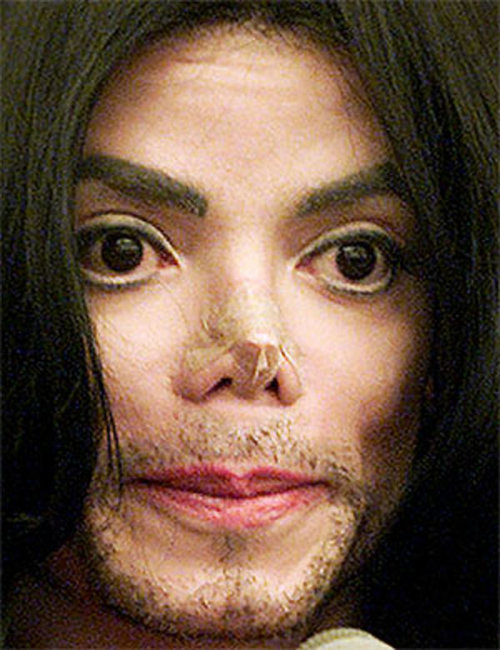Let’s pretend you’re a plastic surgeon for a moment. You’re known for creating the most beautiful, elegant noses. People come from far and wide to have you flare their nostrils and give them a schnoz worthy of the red carpet. One day, you’re sitting in your office, studying the latest edition of Great Noses Quarterly, when you hear the door hinge squeak. Before you hovers the King of Pop himself, the late great Michael Jackson.
This is later-life Michael Jackson, the one with the following (disastrous) nasal appendage:
He tells you that the nose isn’t quite doing it for him. He wants you to work your magic and make it look incredible again.
You sit there, a little dumbfounded. All that can go through your head is “Why didn’t you see me earlier!?”
You adjust yourself in your chair, look him in the eyes, and tell him that you’ll take a peek. You pull some tongs and a little flashlight out and peer up his nose. Whoa. It doesn’t look good. Whoever worked on him before didn’t set up the right bone and soft tissue structure. It’s a bit of a mess. In order for you to work your magic, you’re going to need to have him undergo a couple of operations to solidify the basic structure. The surgeons before him didn’t approach the surgery the right way, they focused on chiseling the tip and shaping the nostrils instead of building a solid shape and create a robust cartilaginous foundation.
Only after you work on Michael’s basics can you do the fancy, highly specialized work that he has sought out.
This is a strange and long-winded way of saying:
You need to nail the basics before doing fancy, behavioral stuff.
I can’t even tell you how many times I’ve started a behavior design project only to figure out that the company didn’t need behavior design, they needed to just put their heads down and work on the fundamental quality and usability of the product.
If you’ve built a photo-based social network, but your app crashes all the time, you need to fix that before doing anything else. If it’s hard to apply filters and edit photos, fix that before trying to develop a really cool point/reward system (or a habit-trigger system).
There’s a hierarchy of needs to a product or service (similar to Maslow’s hierarchy)—make sure you follow it.
I need to think more about how the pyramid is structured, but the reliability and speed of the core elements of your product or feature are at the bottom, while other features, such as smart behavior-triggering, are towards the top.
An ounce of prevention is worth a pound of cure.
Starting things off the right way is imperative. Corrective surgery is never the way to go.
A lot of projects are dead from day 1 because they approach the problem in a behaviorally incorrect manner.
Let me give you a quick example. Back in 2011, I competed in a RFP design challenge for a new app that Aetna was planning on building. They wanted us to build an application that would allow seniors to get medication prompts, health-behavior prompts, and give them the ability to search for key health information, etc. Most people, when given the task of building a product like this, would simply create an application with elegant and simple versions of all these features. Perhaps they would make a home screen with big buttons that would allow the user to tap on what they wanted to do (“get medication info”, “help me diagnose an ache”, etc.). My partner, Neema Moraveji, and I were both behavioral scientists, though. We thought about the product a bit differently. Our first question was: How could we build an app that seniors would keep on? A utility app, similar to the one I just described, wouldn’t be compelling enough. They would likely let their iPads or Android tablets run out of charge… and would have little motivation to charge them back up if the app was a simple health portal. How could we get them excited to use the app? How could we make sure that the app always stayed on?
We decided to make the app, first and foremost, an animated photo gallery. The secondary features would be the health related ones – the “medication reminder” push notifications, the doctor’s visit reminders, the symptom checker, etc. These would be easily accessed via the app, but the home screen would show a selection of photos that the senior would choose and upload (their family members could add photos, as well). This would make it compelling for them to have their tablet on, and in a visible location, at all times. Medication and health reminders are only effective when the user sees them, after all.
I could go on and on about the thinking we put into the app… but here’s the moral of the story: When you’re starting a project, you should work with a behavioral scientist. They can help you figure out the right way to set your project for success.
You don’t want to go back and do massive corrective surgery later.
We ended up winning that RFP, by the way.





